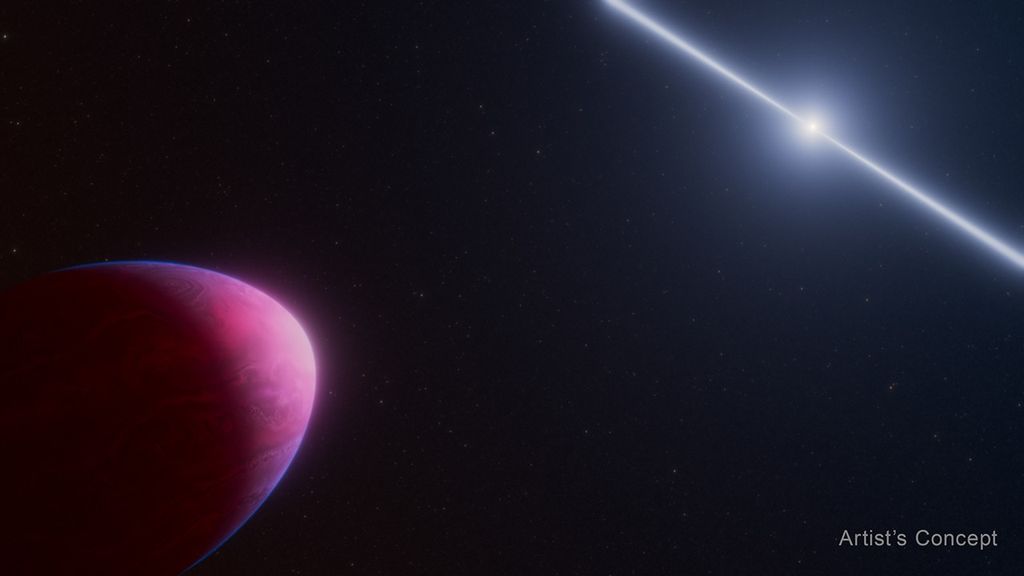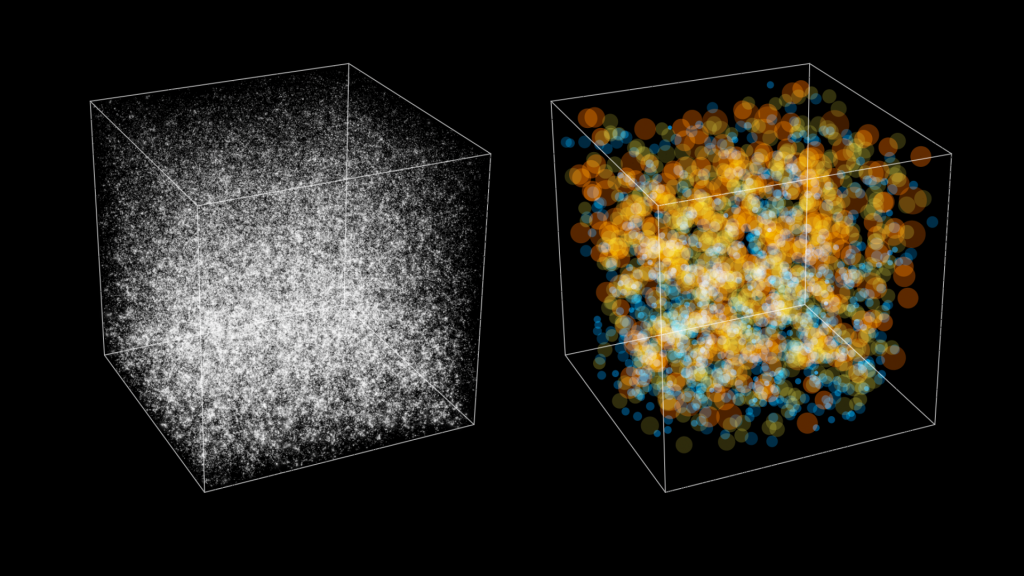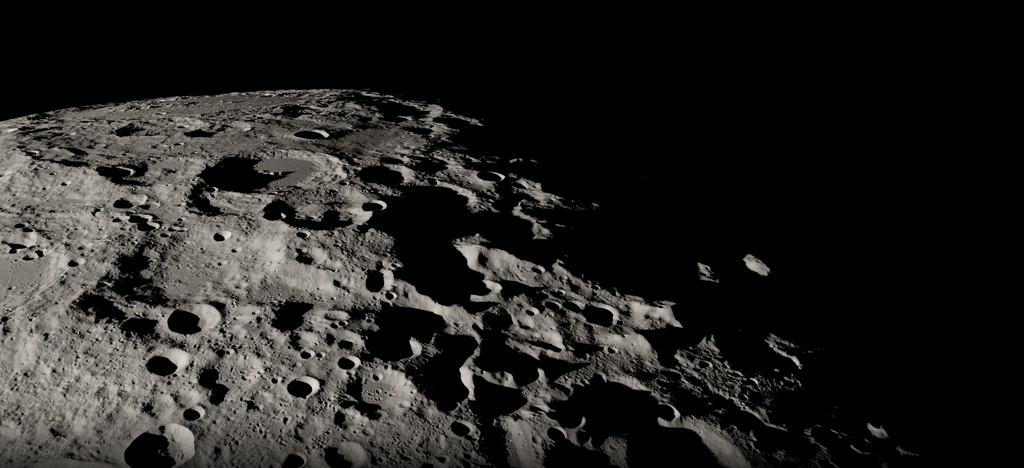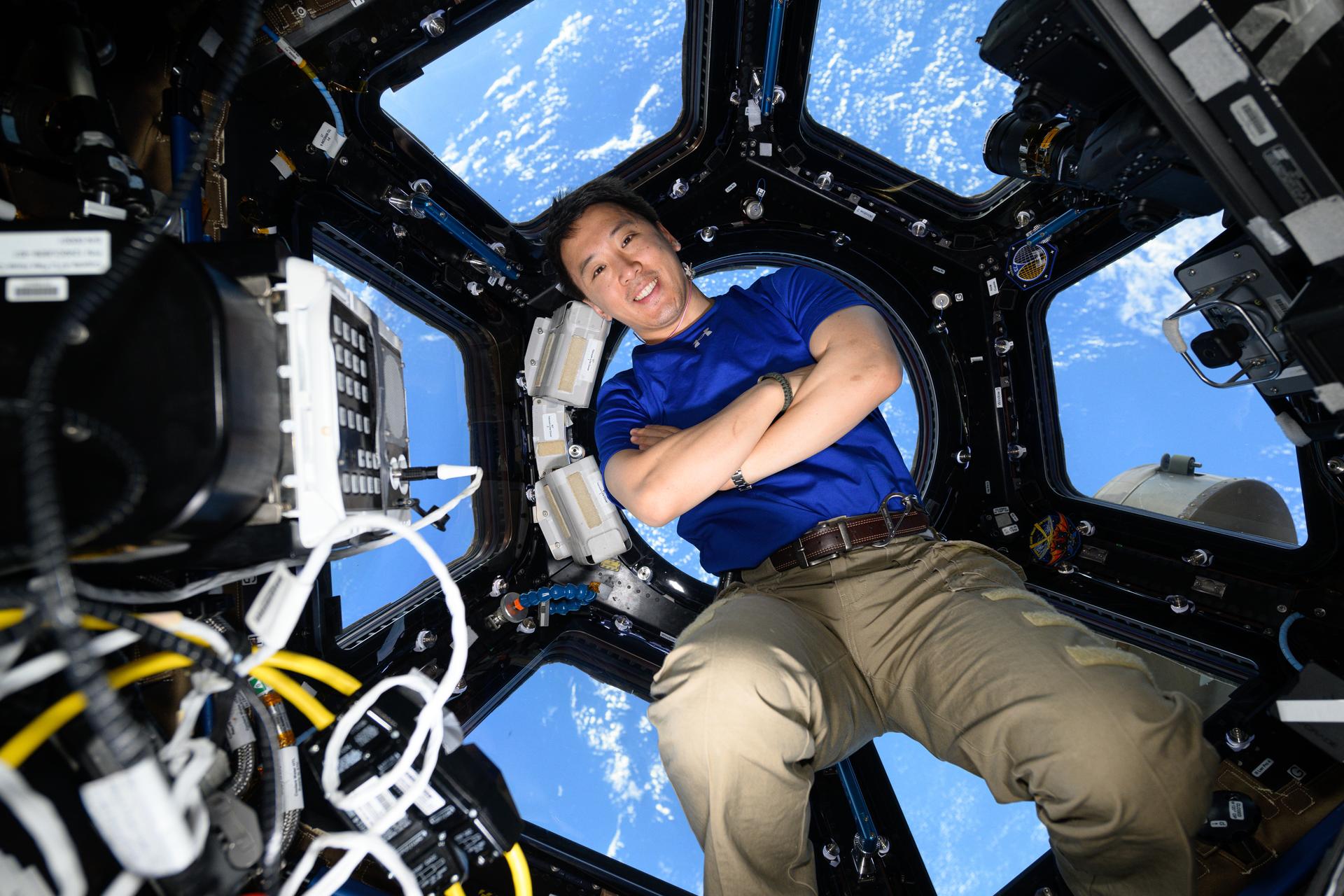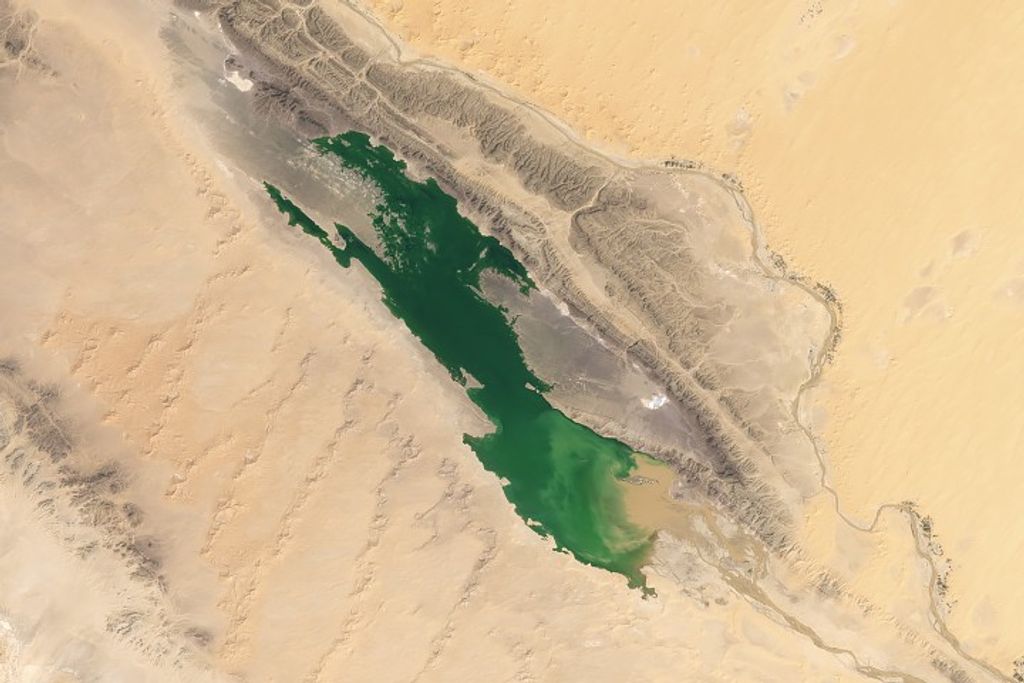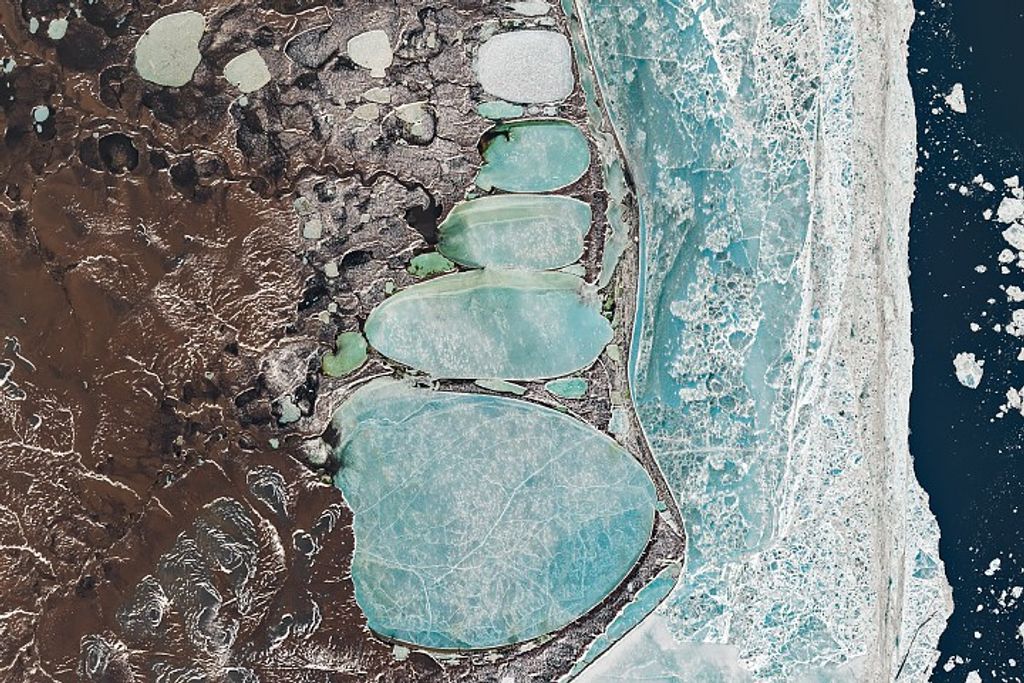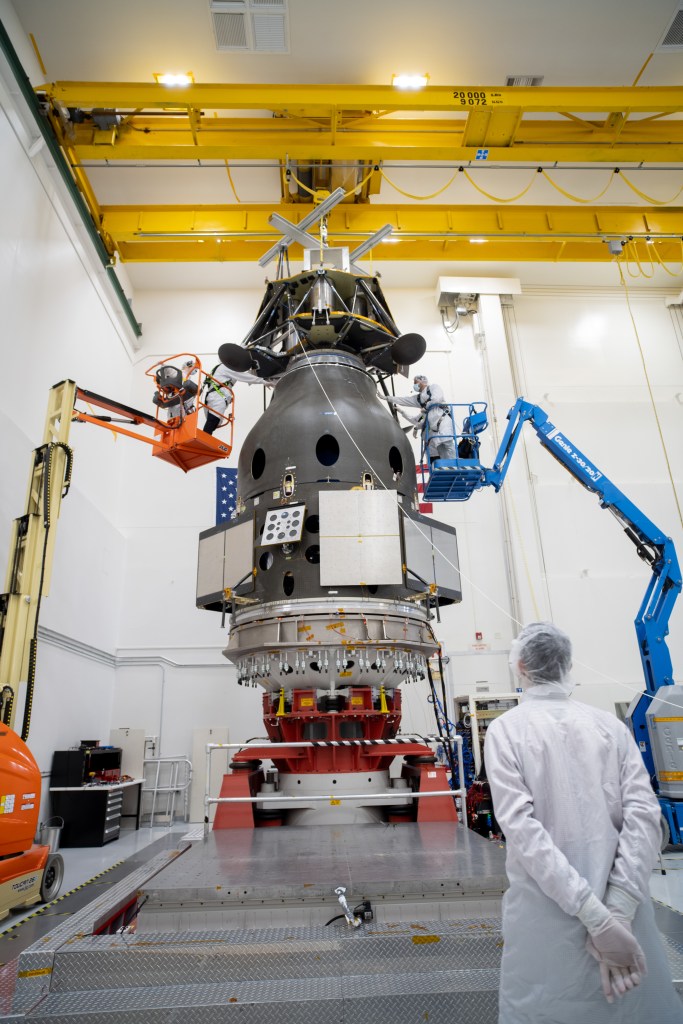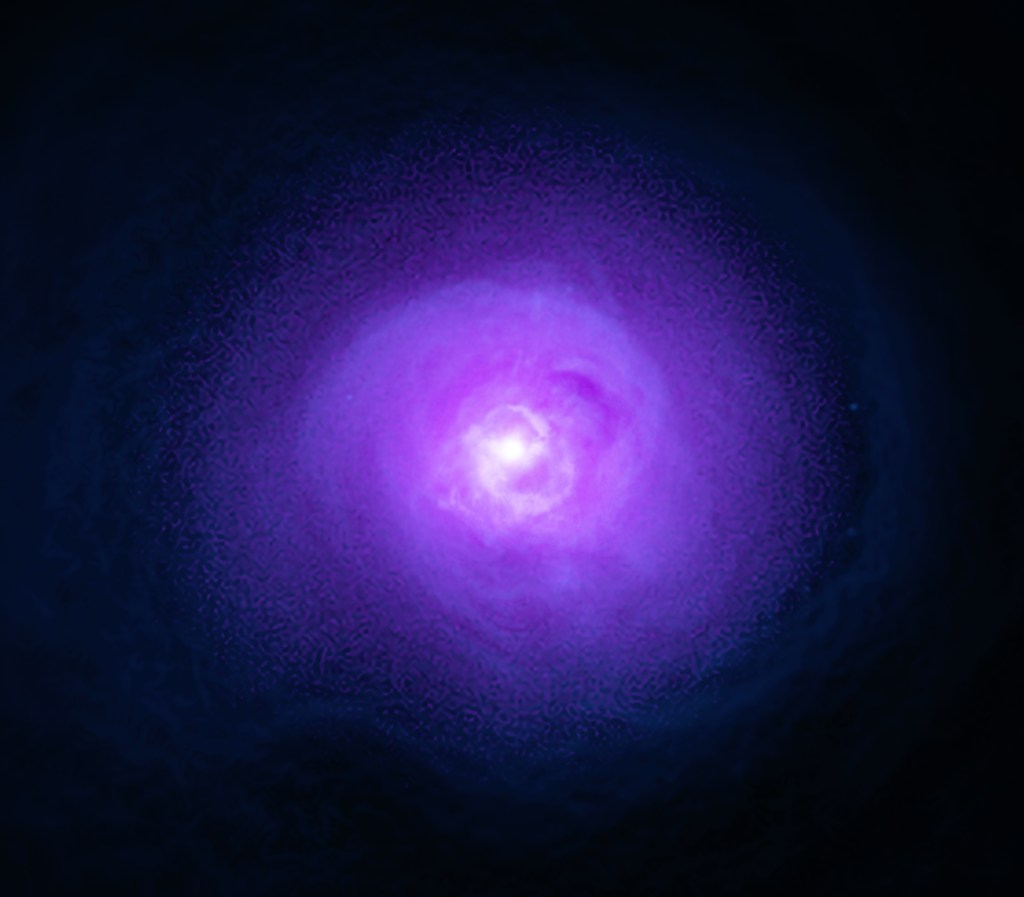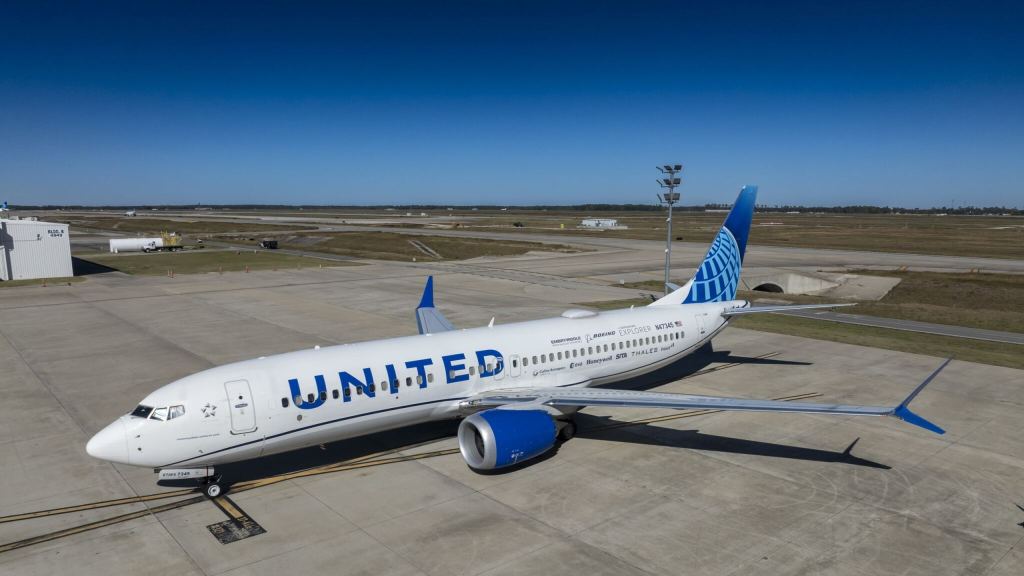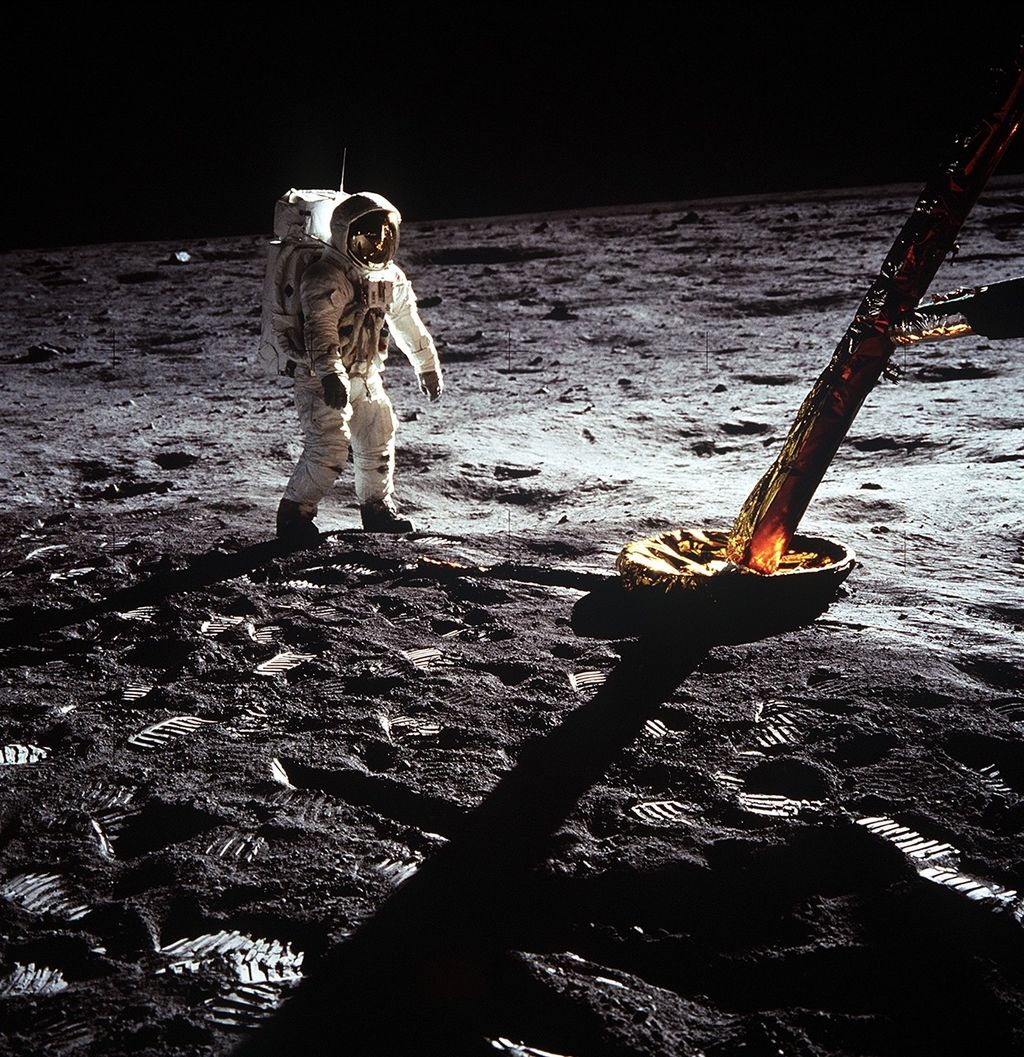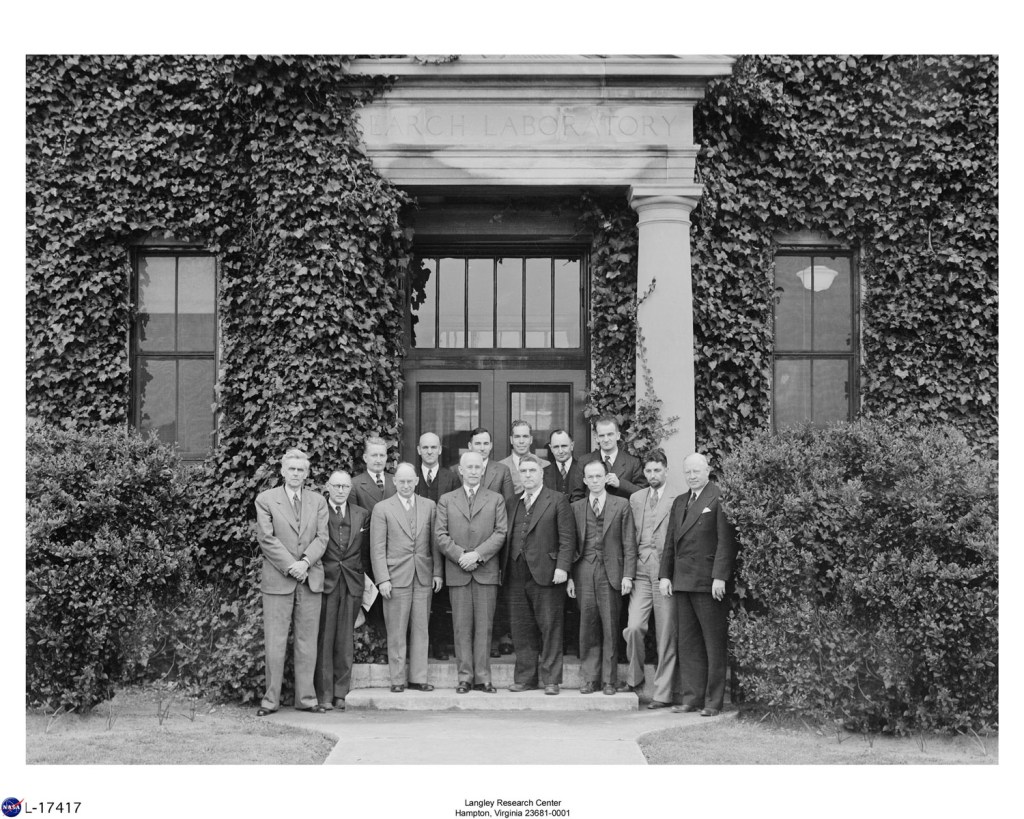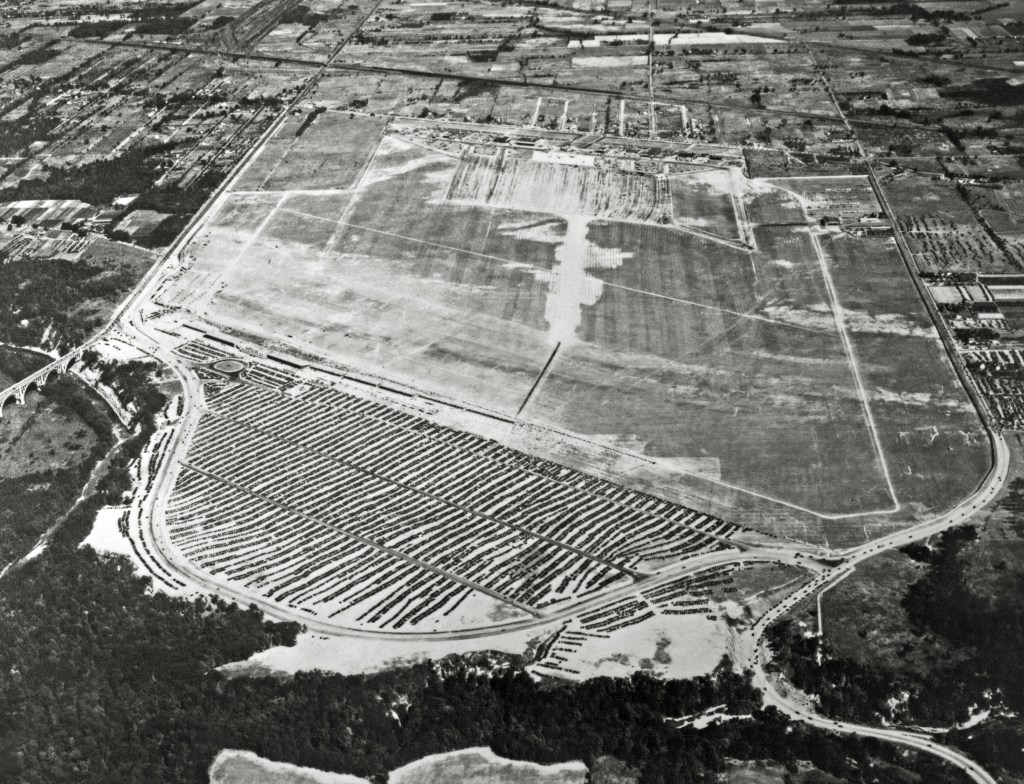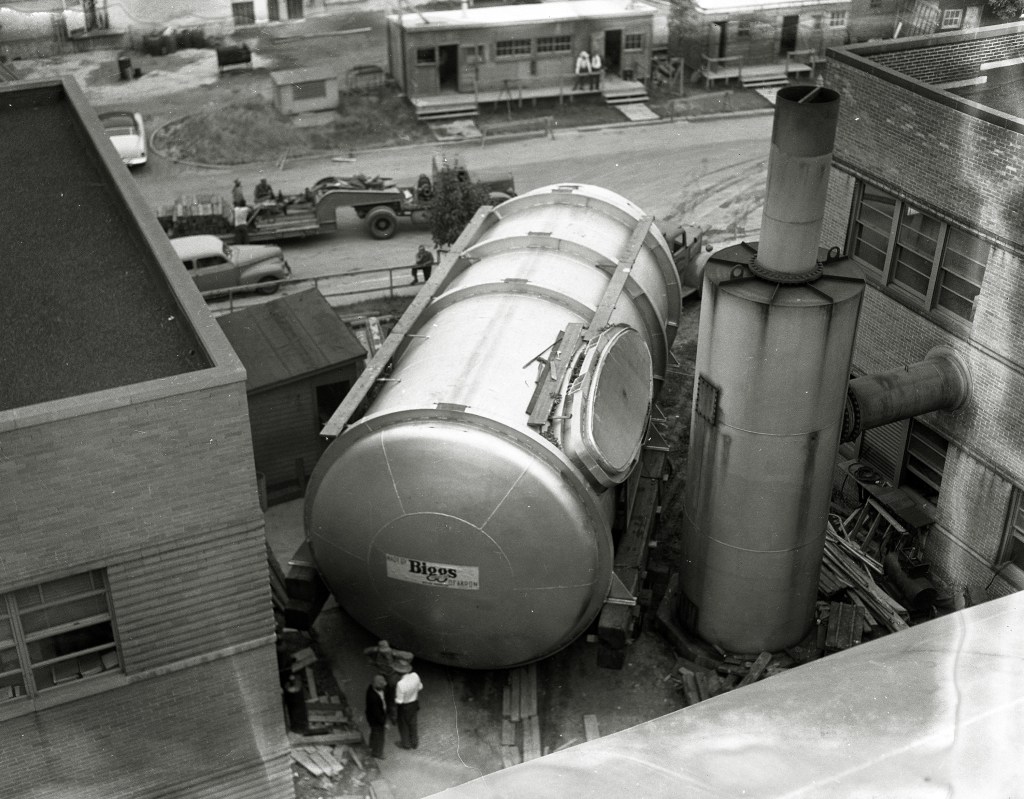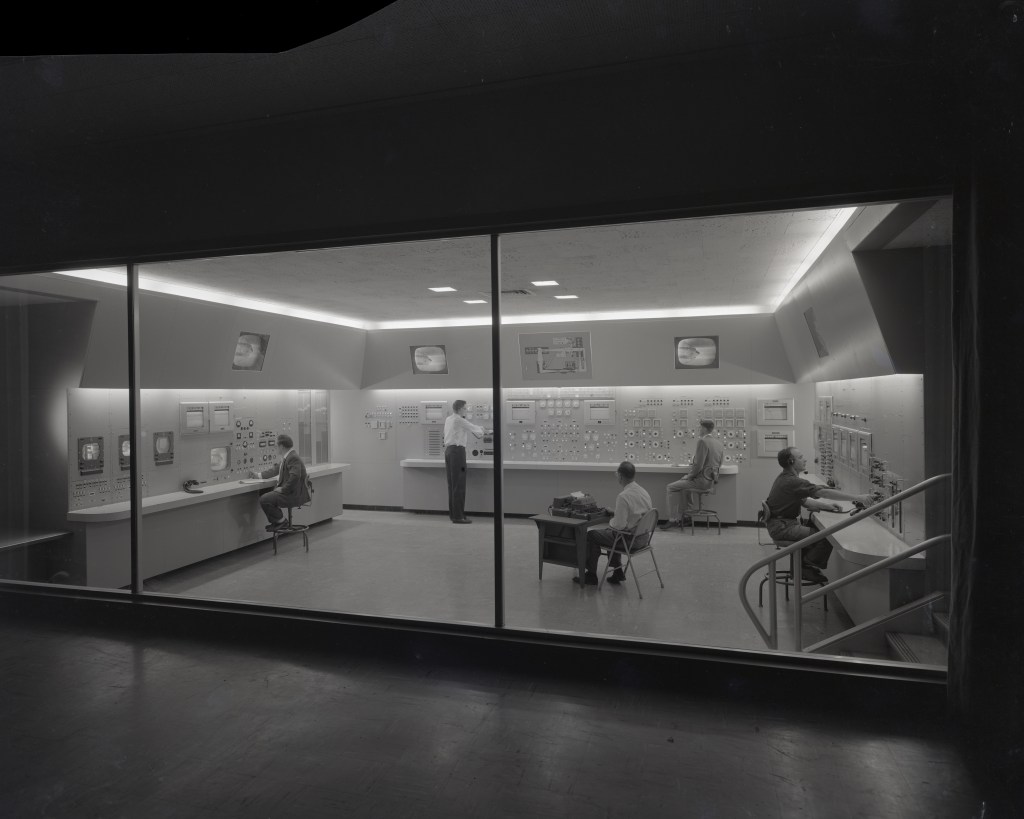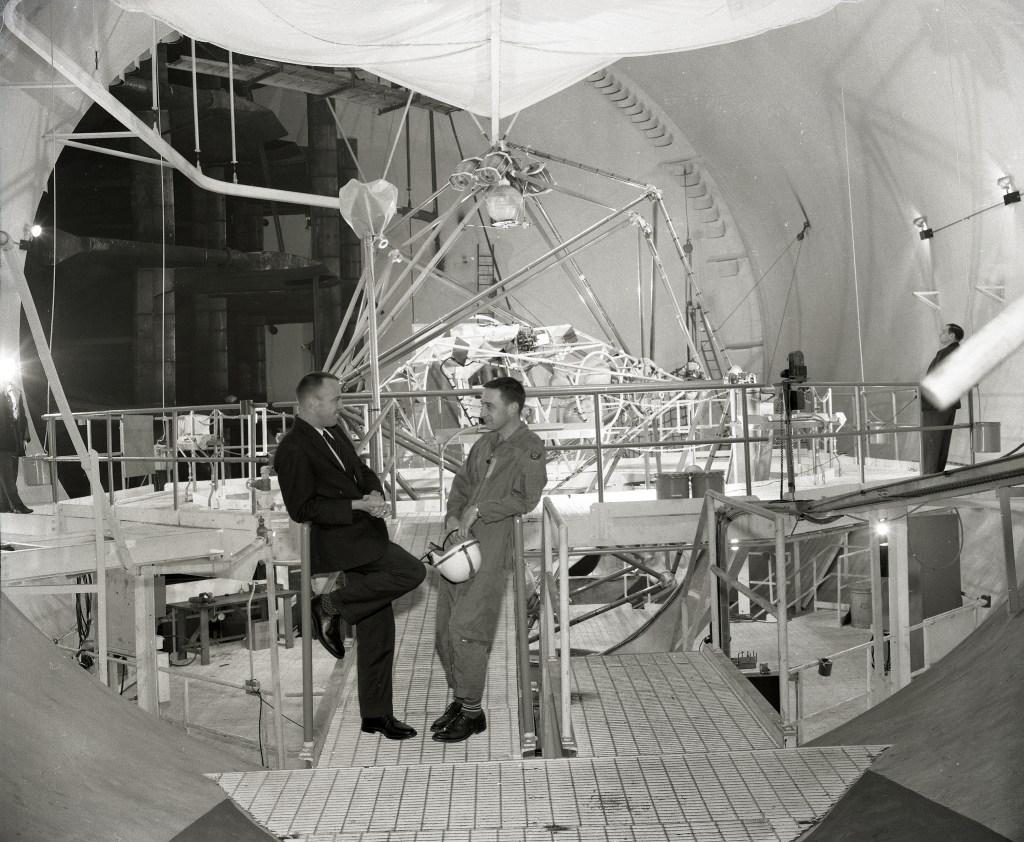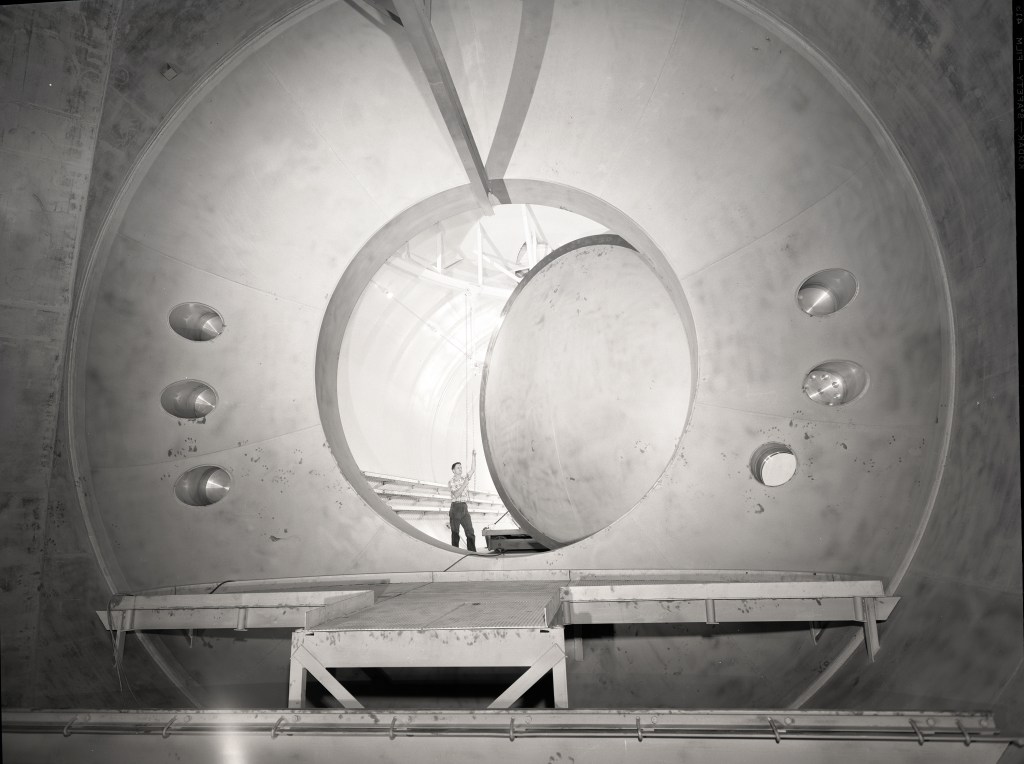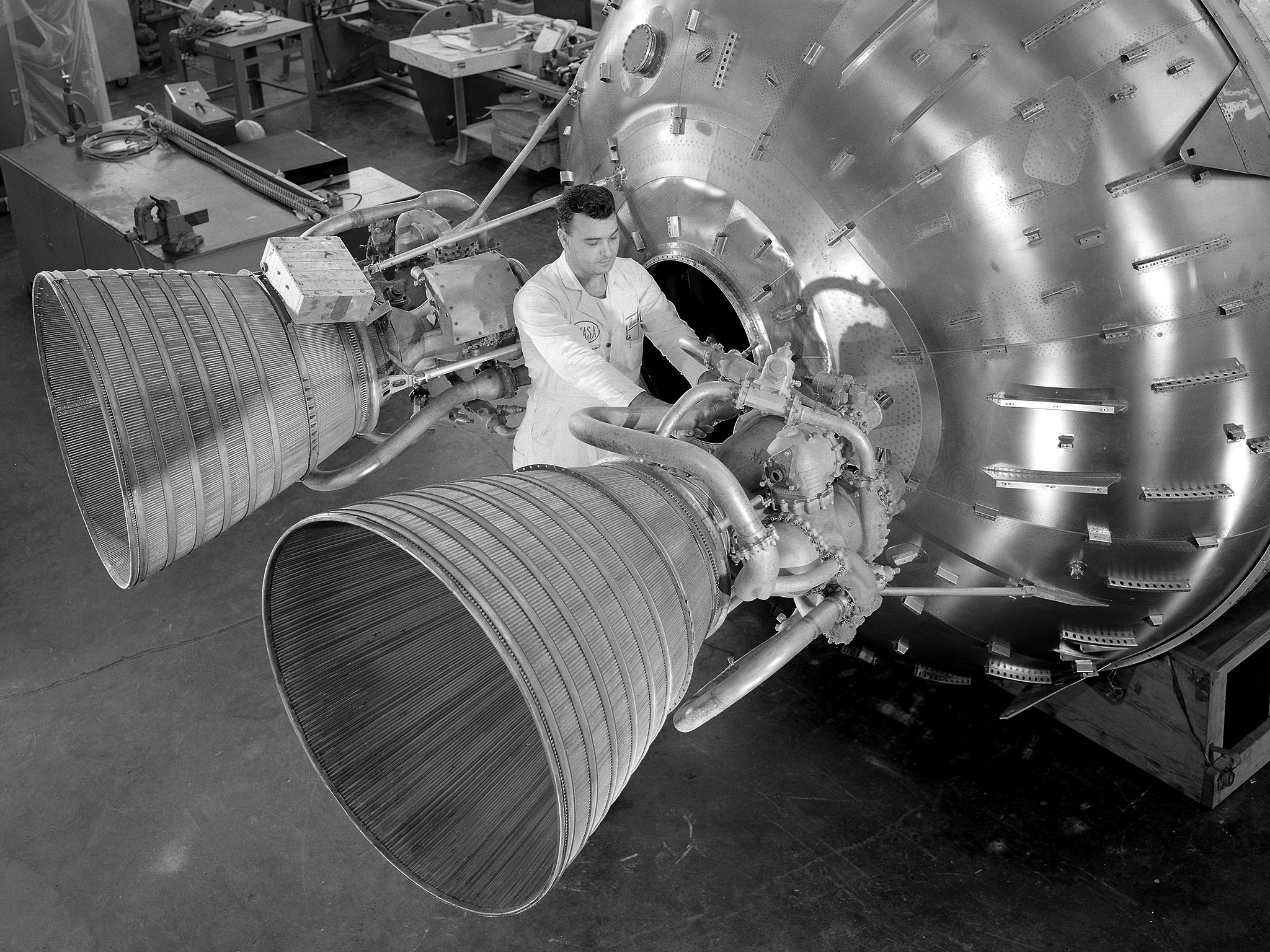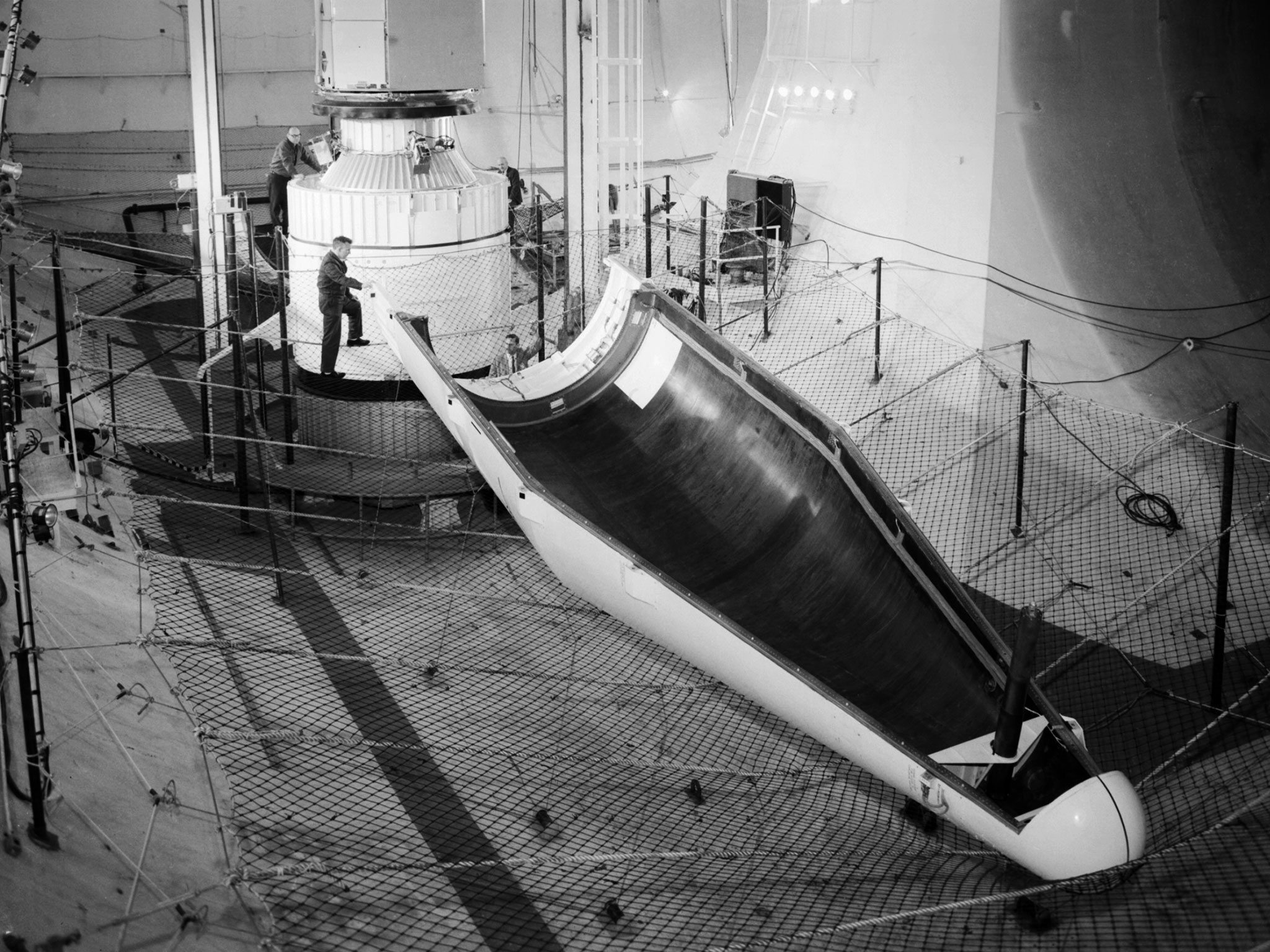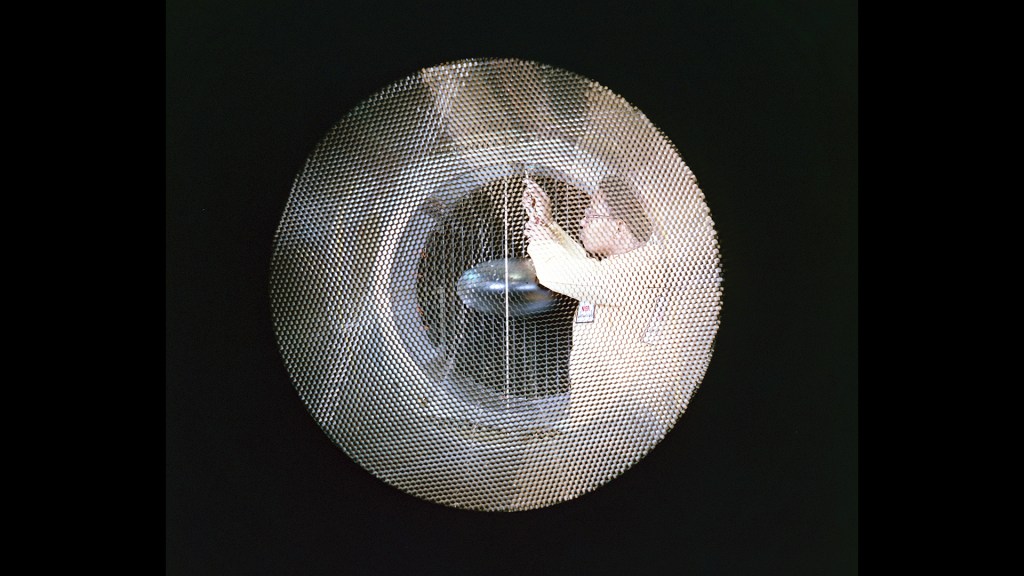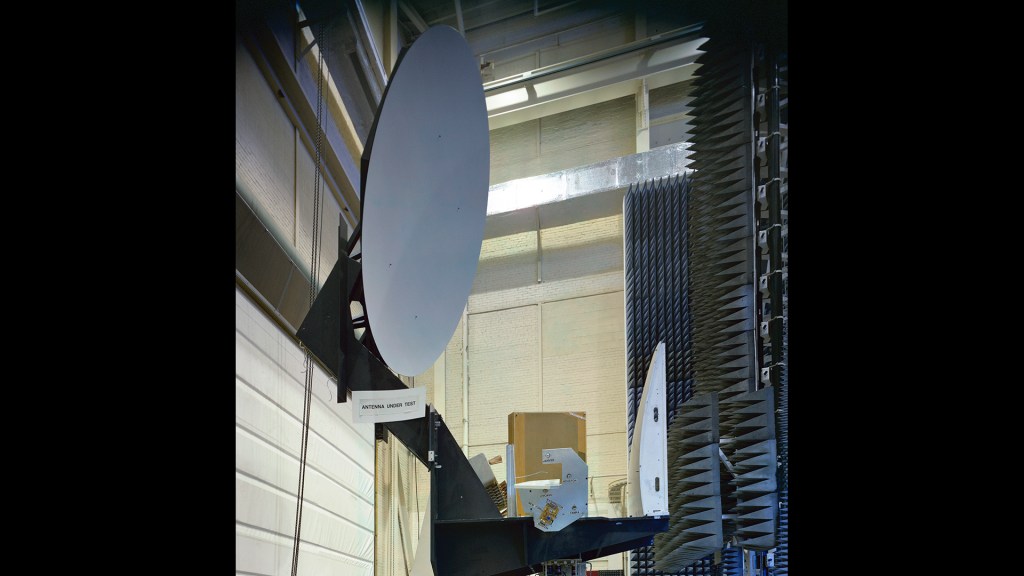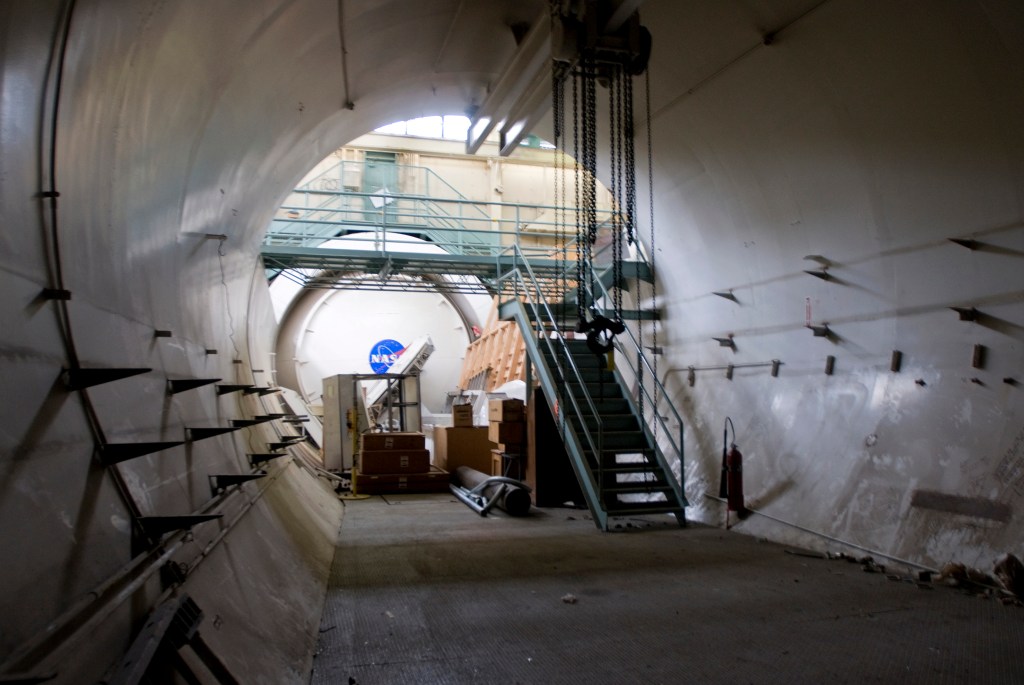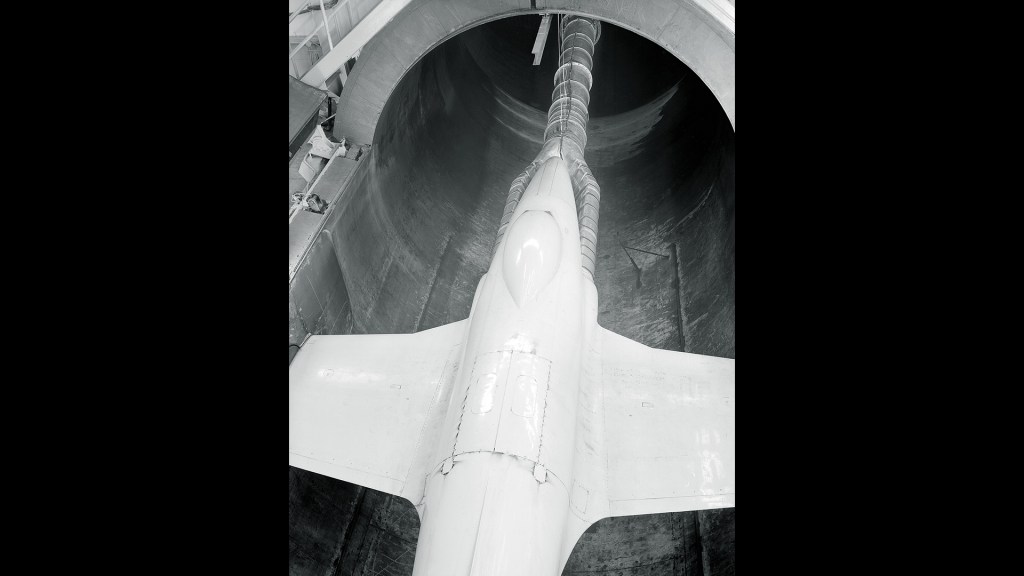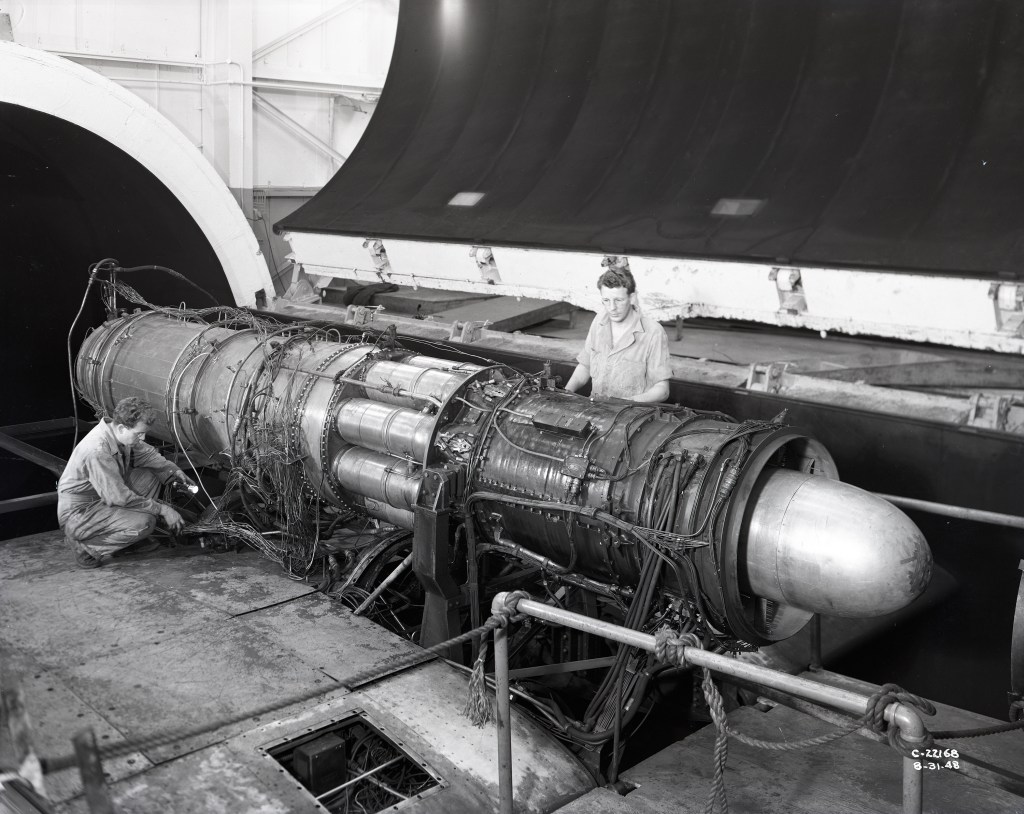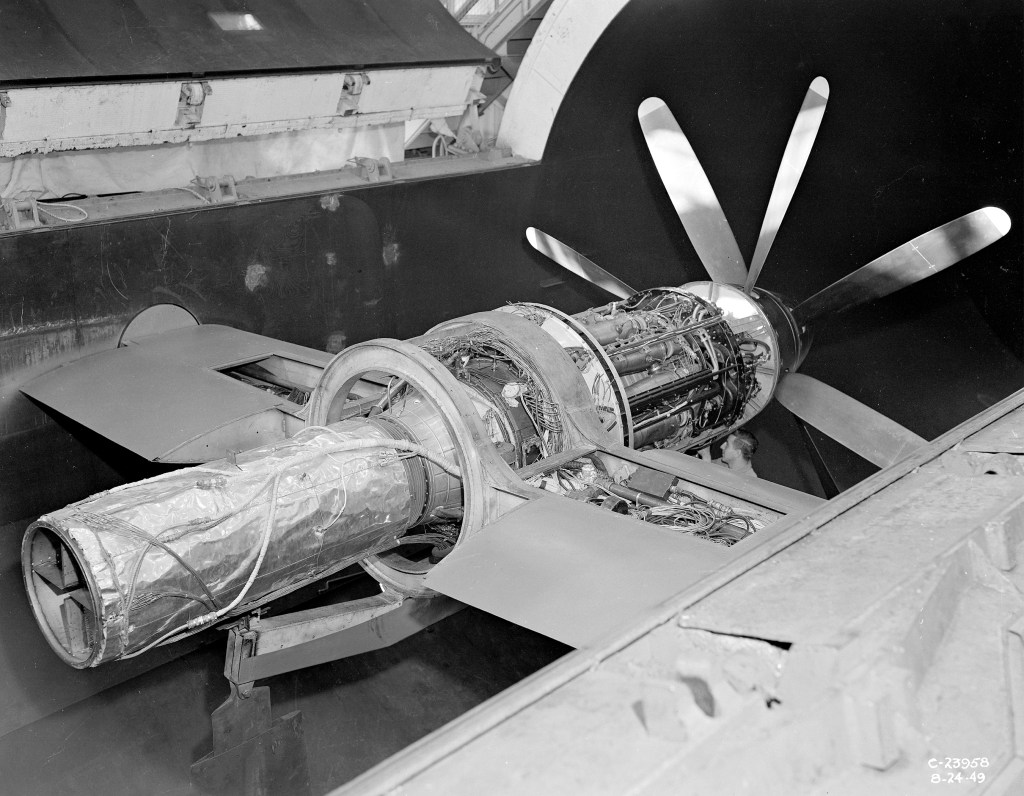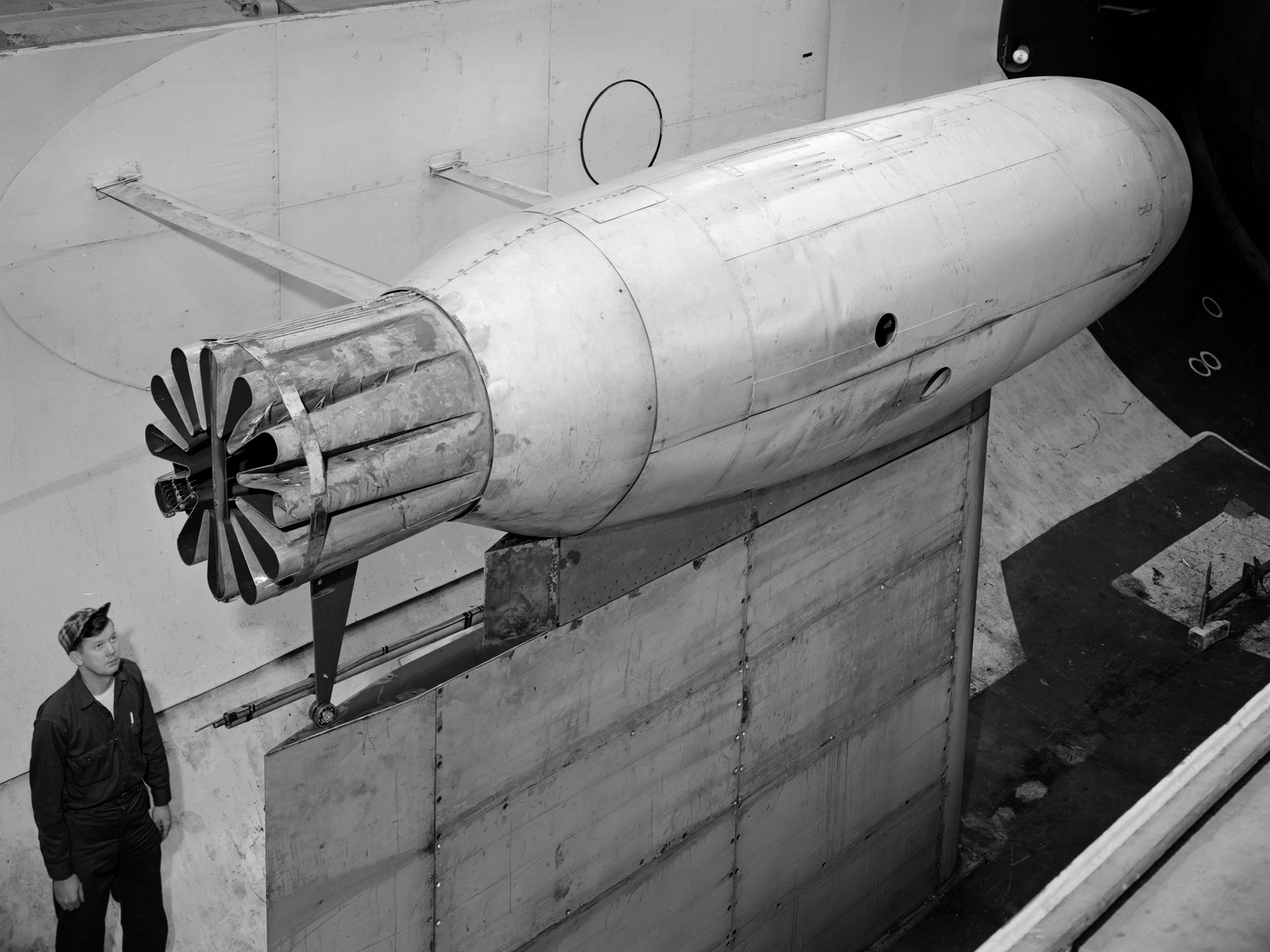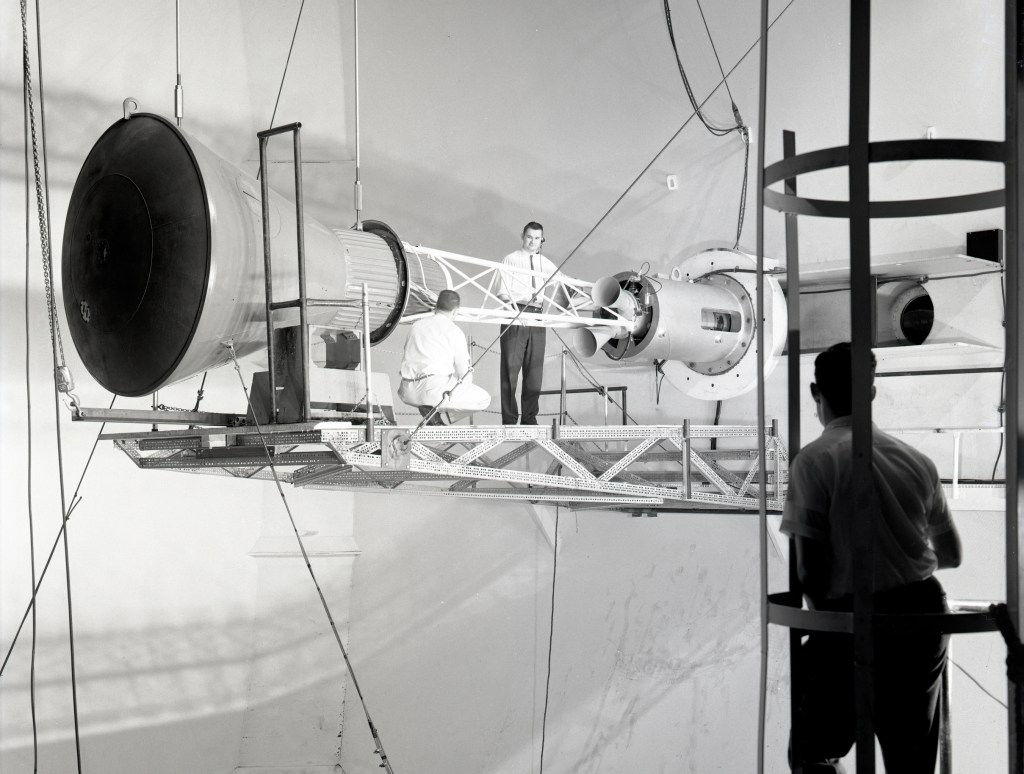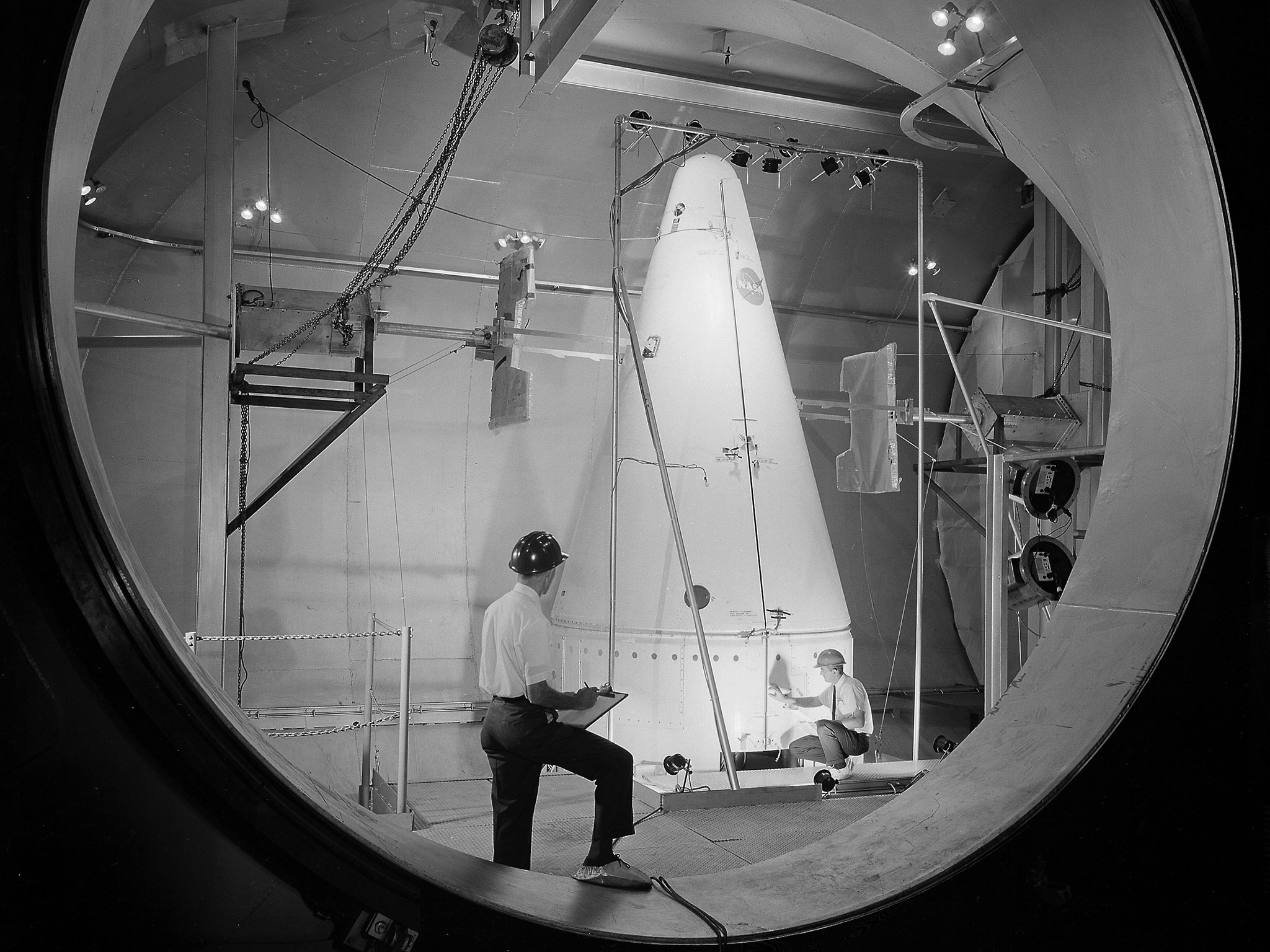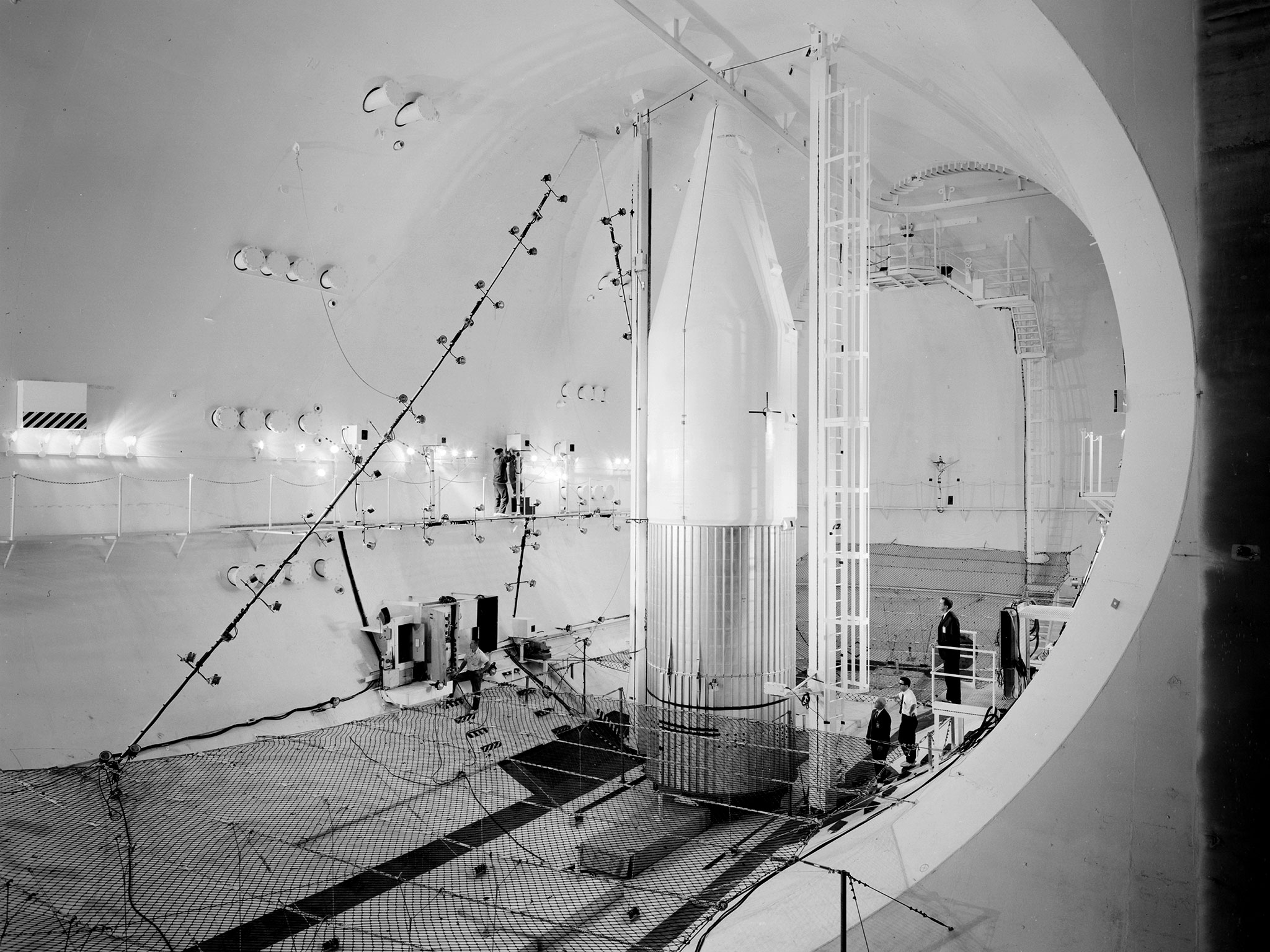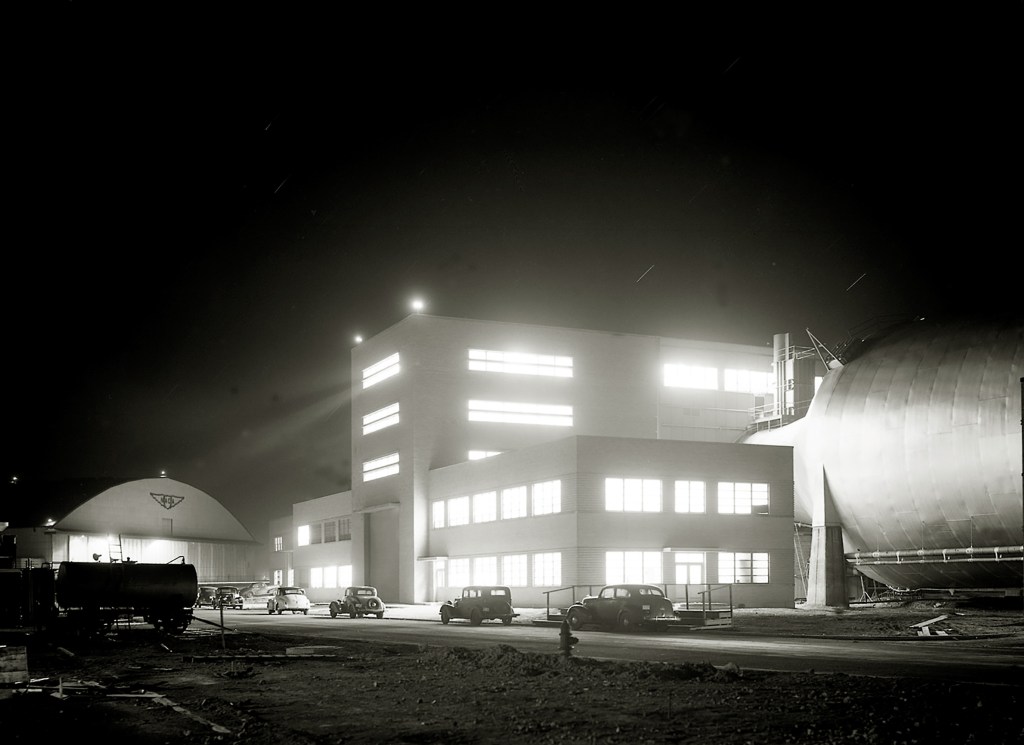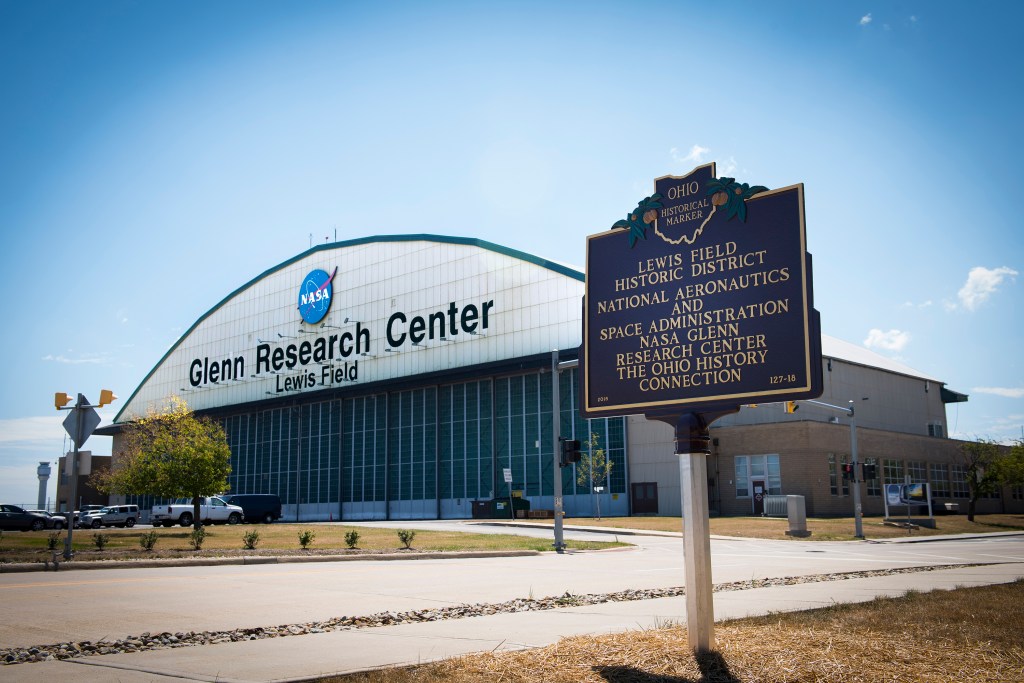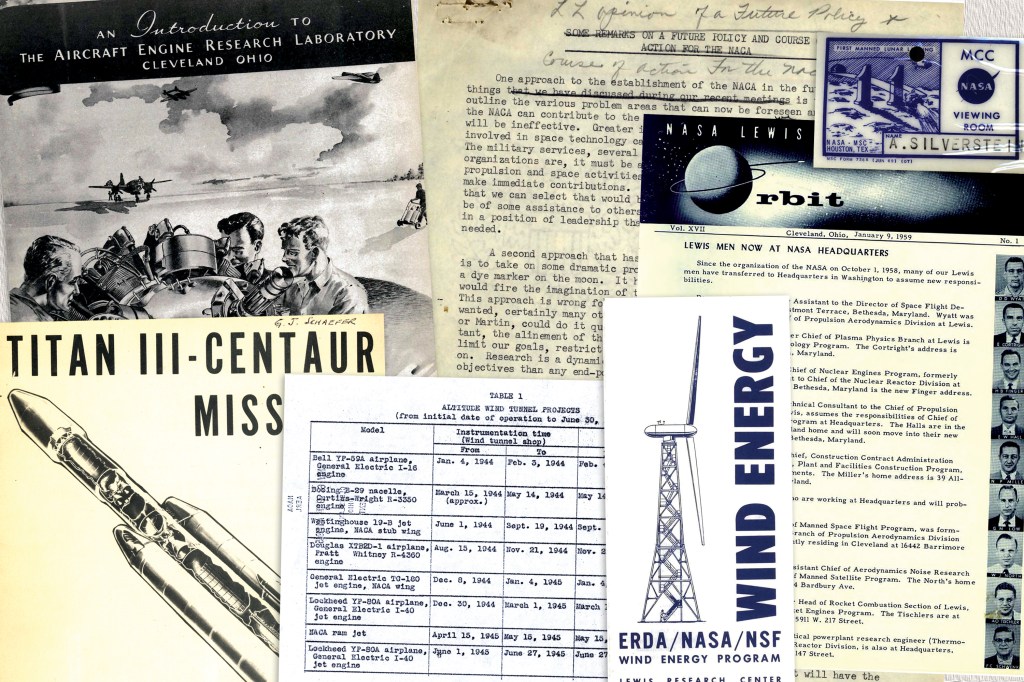NASA Glenn Research Center
Historic Facilities
Altitude Wind Tunnel
Events Timeline (1936 to 2009)
1936
- NACA Committee on Aeronautical Facilities formed
- George Lewis begins visit of Germany aeronautical facilities
- Initiation of NACA Committee on Relation of NACA to National Defense
- First supersonic wind tunnel built at Peenemunde, Germany
1938
- NACA authorizes study on the need for additional research labs
- Wright Brothers Wind Tunnel begins operation at M.I.T.
- Future Research Facilities Special Committee studies a new NACA lab
1939
- Congress appropriates $10 million for a new NACA lab
- German Heinkel He 178 becomes first jet aircraft successfully flown
- NACA selects Moffett Field, California as site for new laboratory
- Charles Lindbergh recommends an NACA engine research plant
- NACA approves establishment of an engine research lab
- Formation of Committee on New Engine Research Facilities
- Construction of Ames Aeronautical Laboratory begins at Moffett Field
1940
- NACA approves the scope and cost estimates for the engine lab
- President Roosevelt calls for annual fabrication of 50,000 U.S. aircraft
- Congress appropriates $8.4 million for NACA engine research lab
- Italians fly thermal jet Campini-Caproni CC–2 aricraft
- NACA board visits Cleveland, Ohio to assess the property for new engine lab
- Edward Sharp named chief of Construction Division at Langley Field
- NACA announces selection of Cleveland, Ohio, for new lab
1941
- Groundbreaking for Aircraft Engine Research Lab (AERL) in Cleveland, Ohio
- Formation of NACA Special Committee on Jet Propulsion
- First flight of British Gloucester E28/39 with Whittle jet engine
- Edward Sharp arrives to oversee construction of the AERL
- General Electric (GE) contracted to build Whittle engine in United States
- United States enters World War II
1942
- Hangar becomes the first building completed at the AERL
- Carrier Corporation wins AWT refrigeration system contract
- Formal initiation of research at the AERL
- General Arnold requests Class 1 priority for AERL construction
- Construction of the AWT begins
- Messerschmitt ME 262 becomes first operational jet aircraft
- First flight of German V–2 rocket at Peenemunde
- First atomic chain reaction at University of Chicago
- Raymond Sharp appointed manager of the AERL
1943
- Elliptical corner rings erected for the AWT
- Westinghouse 19A becomes the first U.S.-designed jet engine
- Installation of AWT drive motor and flash cooler
- GE I–16 turbojet engine secretly tested in Jet Propulsion Static Lab
- Abe Silverstein transfers from Langley to Cleveland
1944
- AWT becomes operational
- AWT tests first U.S. jet aircraft and the B–29’s R–3350 engine
- General Henry H. Arnold visits the AERL
- Icing Research Tunnel begins operation
1945
- Japanese surrender ends World War II
- Major reorganization of AERL to focus on jet engines
- AWT is modified to muffle low-frequency vibrations
- George Lewis suffers two heart attacks
- Construction of 8- by 6-Foot Supersonic Wind Tunnel begun
1946
- First successful U.S. operation of afterburner in AWT
1947
- AERL renamed Flight Propulsion Research Laboratory
- First supersonic flight by Chuck Yeager in X–1
- NACA conducts AWT Fan and Tunnel Survey
- Lab renamed the Lewis Flight Propulsion Laboratory
1948
- 8- by 6-Foot Supersonic Wind Tunnel begins operation
1949
- Abe Silverstein becomes director of research
- Research divisions reorganized for supersonic flight
1951
- AWT undergoes major upgrade and modernization
1952
- Propulsion Systems Laboratory begins operation
- Korean War begins
1953
- AWT operation reduced due to modernization project
- Air Force’s Propulsion Wind Tunnel begins operation
1955
- 10- by 10-Foot Supersonic Wind Tunnel completed
- Hydrogen engine tested in AWT for Project Bee
- Walter Olsen issues paper on future rocket propulsion research
1957
- Soviet Union launches Sputnik I and II
- Lewis hosts NACA Inspection and Flight Propulsion Conference
- B–57 flies on liquid hydrogen for Project Bee
1958
- NACA Lewis incorporated into the new NASA space agency
- AWT shut down for tunnel leak test; end of use as a wind tunnel
1959
- Big Joe Mercury capsule mock-up tests in AWT
- Launch of the Big Joe boilerplate capsule
- Lewis tasked with five Project Mercury tasks
- Interior of west end of AWT gutted for Mercury tests
1960
- Mercury astronauts train in MASTIF rig inside the AWT
- Mercury escape tower tests in the AWT
- Failure of the Mercury-Redstone 1 launch
1961
- Yuri Gagarin becomes first human in space
- Alan Sheppard becomes first American in space
- Abe Silverstein returns to Lewis as center director
- Conversion of AWT to the Space Power Chambers (SPC) begins
1962
- First Centaur (F–1) launch fails
- Surveyor program substitutes Centaur for Agena rocket
- AWT is renamed the SPC
- Transfer of the Centaur Program to NASA Lewis
1963
- Transfer of the Agena Program to NASA Lewis
- Installation of dome on SPC No. 1
- Atlas/Centaur separation tests are first SPC tests
- Atlas/Centaur-2 successfully launched
1964
- Centaur rocket inserted into SPC No. 1
- Cleveland Parade of Progress Exposition features NASA
- Atlas/Centaur-4 launches Surveyor model
- Atlas/Centaur-5 explodes on launch pad
1965
- Atlas/Centaur-6 launches successfully
- Atlas/Centaur-8 systems tests in SPC No. 1
- Orbiting Astronomical Observatory-1 satellite launches
1966
- Atlas/Centaur-8 launches
- Transfer of the RL–10 engine program to NASA Lewis
1967
- Surveyor spacecraft makes first landing on Moon
1968
- Creation of the Launch Vehicles Division
- Launch of Orbiting Astronomical Observatory-2 satellite
- 9- by 15-Foot Low-Speed Tunnel added to 8- by 6
1970
- Failed Orbiting Astronomical Observatory-B launches
1971
- Shop area used to prep Research Propulsion Module and jet engines
- Study into rehab of AWT for Vertical/Short Takeoff and Landing testing
1972
- Shop area used for electric automobile studies
- Orbiting Astronomical Observatory-C satellite launches
1973
- Rehab of the Shop and Office Building
- NASA Lewis closes Plum Brook Station [Today, the Neil Armstrong Test Facility]
1975
- Centaur Equipment Module becomes SPC’s last test
1976
- Concord flies first flight
1978
- Icing Research Tunnel restored to operational status
1979
- Propulsion Systems Laboratories 1 and 2 closes
1980
- Formation of Project Office to study restoration of the AWT
1982
- Conversion of AWT shop area into the Microwave Systems Lab
1984
- Lewis hosts Wind Tunnel Modeling Seminar
- Centaur removed from AWT as part of rehab preparations
1985
- Congress cancels AWT rehab project
1989
- Center cleans up Mercury contamination at AWT site
1990
- Expansion of the Shop Area and High-Bay area begins
1995
- Former control rooms converted into offices
2003
- Center receives $4 million estimate to repaint AWT shell
2004
- NASA releases AWT demolition requirements documents
2005
- Center begins planning demolition of the AWT
- AWT historical mitigation work begins
2006
- Community Awareness Meeting held prior to demolition
2007
- History Office documents history of the AWT
2008
- Demolition of the AWT begins
2009
- Demolition of the AWT completed
Testing Timeline (1944 to 1975)
1944
- Bell YP–59A Airacomet (J–31/GE I–16)
- Boeing B–29 Superfortress (Wright R–3350)
- Westinghouse 19B and 19XB (J–30)
1945
- Douglas XTB2D–1 Skypirate (Pratt & Whitney 4360)
- GE TG–180 (J–35) and afterburner
- Lockheed YP–80A Shooting Star (J–33/GE I–40)
- NACA 20-inch-diameter ramjet
- Lockheed TP80S F–80 (J–33/GE I–40)
- Republic YP–47M Thunderbolt propeller tests
- Lockheed XR–60 Constitution (Pratt & Whitney 4360)
1946
- NACA 20-inch-diameter ramjet
- GE TG–180 (J–35) and afterburner
- GE TG–100A turboprop
1947
- Westinghouse X24C–4B (J–34)
- GE TG–180 (J–35) and afterburner
1948
- Johns Hopkins 18-inch-diameter ramjet
- GE TG–180 (J–35) and afterburner
- GE TG–190G
1949
- NACA 16-inch ramjet
- GE TG–190G (J–47) high-altitude-starting
- Armstrong–Siddeley Python turboprop
1950
- GETG–19D (J–47) B–7 and RX engines
- Westinghouse 24C–7 and 24C–8 (J–46) afterburner and cooling
1951
- Westinghouse J–40–WE6
1952
- Allison J–71
1953
- Westinghouse XJ34–WE–32 without electronic control
1954
- Pratt & Whitney J–57 and J–57–P–1 airflow
1955
- Wright J–65–B–3 hydrogen transfer test
- Allison J–71
1956
- Rolls-Royce Avon engines (J–54)
1957
- Pratt & Whitney J–57 noise suppression
1958
- Ace piloted ramjet
- NASA-designed solid rocket
- Atlantic Research Arcite solid rocket
1959
- NASA One Axis Table
- NASA storable propellant
- Big Joe capsule guidance system
- Hydrogen peroxide thruster
- Big Joe II capsule guidance system
1960
- Redstone separation and retrograde rockets
- Atlas reparation and retrograde rockets
- Multi-Axis Spin Test Inertial Facility (MASTIF)
- Escape tower rockets
- Posigrade rocket separation
- Retrorocket rocket braking
1961
- Mercury Evaporating and Condensing Analysis (shop)
1962
- S–65 satellite model (SPC No. 1)
1963
- Atlas/Centaur retrorockets (SPC No. 2)
1964
- Atlas/Centaur-4 Surveyor nose cone (SPC No. 1)
1965
- Centaur electronic systems (SPC No. 1)
- Centaur insulation panels (SPC No. 2)
- Atlas/Centaur-6 Surveyor nose cone (SPC No. 1)
- Centaur Vent Valve Test Rig (SPC No. 2)
- Orbiting Astronomical Observatory (OAO)—1 shroud (SPC No. 2)
1966
- Hydrogen Vent Test Rig (SPC No. 2)
- Weightless Analysis Sounding Probe (SPC No. 1)
1967
- Atlas launcher shaft (high-bay)
- Surveyor Atlas/Centaur Shroud leak test
- Weightless Analysis Sounding Probe (SPC No. 1)
- Helium bottle blowdown (SPC No. 2)
- Hydrogen peroxide engine (SPC No. 2)
1968
- Centaur/Orbiting Astronomical Observatory (OAO)—2 (SPC No. 2)
1971
- Centaur/OAO—B shroud (SPC No. 2)
1972
- Centaur/OAO—C shroud (SPC No. 2)
- Centaur D–1A shroud (SPC No. 2)
1975
- Centaur/High Energy Astrophysical Observatories module (SPC No. 2)
Wind Tunnel Development Timeline
Wind tunnels have been used for studying the elements of flight since 1871. Initially, they were small-scale, open-loop devices such as the Wright Brothers’ tunnel with its 16-inch test section. Wind tunnels grew in size and complexity, particularly after the Ludwig Prandtl first closed-loop tunnel in 1909. Tunnels were built in a variety of sizes and shapes with varying speeds depending on the current technology and their intended areas of study. The AWT was the first wind tunnel built to study engine performance in altitude conditions. A list of important wind tunnels is below.
1871
- Frank Wenham designs the first wind tunnel (Great Britain).
- V.A. Pashkevich designs wind tunnel (Russia).
1897
- Konstantin Tsiolkovsky creates first Russian wind tunnel.
1901
- The Wright Brothers build their first wind tunnel (Dayton, OH).
1901
- Albert Zahm designs first significant U.S. tunnel (Catholic University).
1909
- Ludwig Prandtl designs the first closed-loop wind tunnel (Germany).
1912
- Gustav Eiffel builds twin tunnels sharing common chamber (France).
1917
- Ludwig Prandtl designs the first modern wind tunnel (Germany).
1922
- National Physical Laboratory builds first supersonic tunnel (Great Britain).
1923
- Max Munk designs the Variable Density Tunnel at NACA Langley.
1927
- Propeller Research Tunnel begins operation at NACA Langley.
1931
- Smith DeFrance’s Full Scale Tunnel is completed at NACA Langley.
1937
- Supersonic wind tunnels built for V-2 research at Peenenemunde (Germany).
1938
- Massachusetts Institute of Technology builds altitude tunnel (Boston, MA).
1939
- 16-Foot High Speed Tunnel begins operation at NACA Langley.
- Kirsten High-Speed Tunnel conducts first test (Seattle, WA).
1942
- First U.S. supersonic tunnel built at NACA Langley.
1944
- Altitude Wind Tunnel begins operations at NACA Cleveland Lab.
1944
- 40- by 80-Foot Tunnel completed at NACA Ames.
1948
- 8- by 6-Foot Supersonic Wind Tunnel completed at NACA Lewis.
1955
- 10- by 10-Foot Supersonic Wind Tunnel completed at NACA Lewis.
1955
- Propulsion Wind Tunnel at AEDC conducts first test run.
Vacuum Chamber Development Timeline
The first sustained vacuum was achieved in 1643, and the first vacuum pump followed in 1650. As humans began flying aircraft in the early 1900s, engineers began testing engines in vacuum chambers to simulate conditions at higher altitudes. As the nation began sending spacecraft into space decades later, there was a need for test chambers capable of producing higher levels of vacuum. The SPC was among the first of a wave of large vacuum chambers that emerged in the early 1960s. The Space Power Facility (SPF) at NASA’s Plum Brook Station, which began operation in 1969, is the largest vacuum chamber in the world. A list of vacuum chambers used to simulate altitude is below.
1917
- Bureau of Standards’ first test in altitude chamber for the NACA.
- High-altitude test bench at Zeppelin Aircraft Works (Germany).
1918
- U.S. School of Aviation Medicine creates altitude tank.
1933
- National Bureau of Standards tests appliances in a high-altitude chamber.
1938
- MIT Wright Brothers Wind Tunnel simulates altitude.
1944
- The NACA’s AWT begins operation at NACA Lewis.
1947
- Four Burner altitude test stands built at NACA Lewis.
1952
- The NACA Propulsion Systems Laboratory’s two altitude test cells begin operation.
1959
- Interior of AWT gutted to create high-altitude chamber.
1960
- McDonnell builds space environment chamber for Project Mercury.
1961
- Electric Propulsion Laboratory vacuum tanks built at NASA Lewis.
- Republic Aviation Space Simulation Facility.
1962
- SPC No. 1 vacuum chamber built inside the AWT.
- Goddard Space Environment Simulator begins operation.
- Lockheed’s High Vacuum Orbital Simulator.
- Bendix Corporation’s Space Simulation Chamber.
- GE Space Environment Simulator.
- 25-Foot Space Environment Facility at Jet Propulsion Laboratory.
1963
- Mark I Aerospace Simulator at the AEDC.
1965
- Space Environment Simulation Laboratory at Johnson Space Center.
1969
- Space Propulsion Research Facility at Plum Brook tests rocket engines in vacuum.
- Space Power Facility at Plum Brook becomes the world’s largest vacuum chamber.


